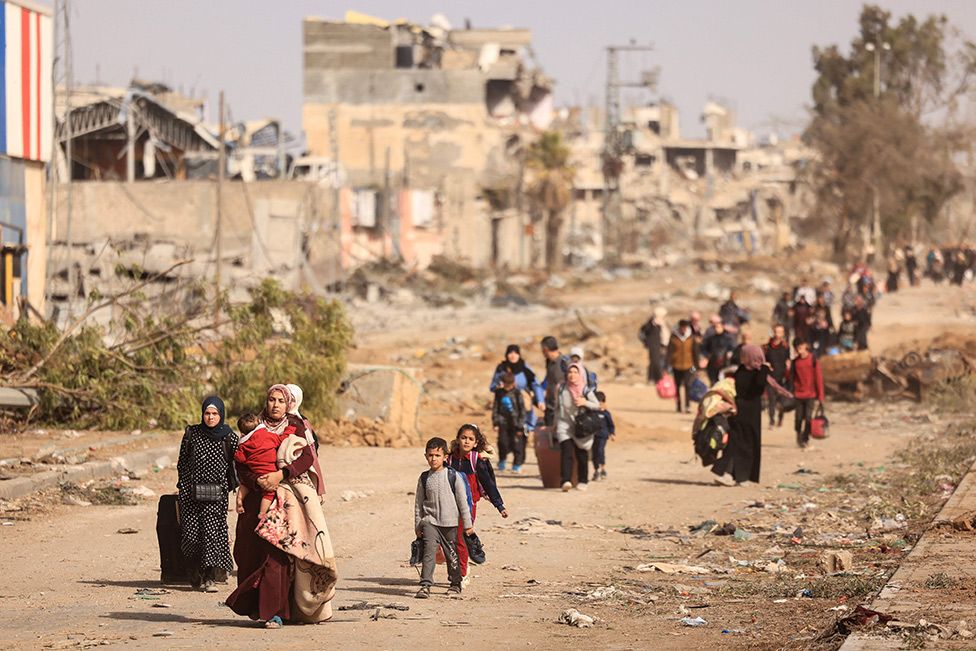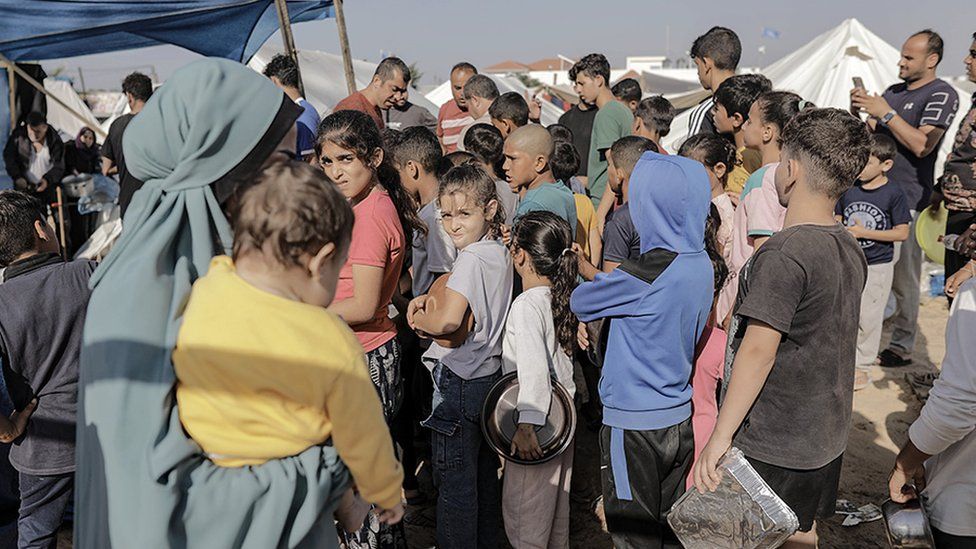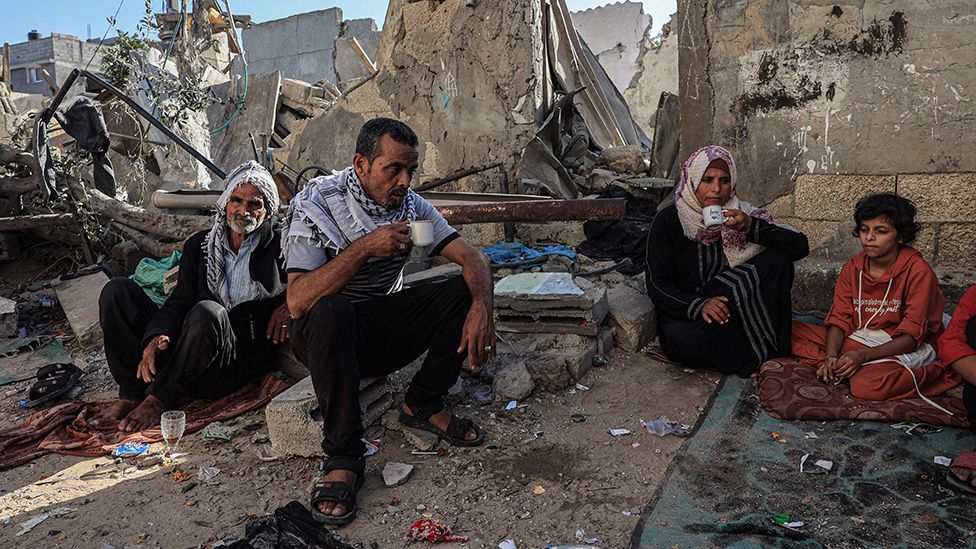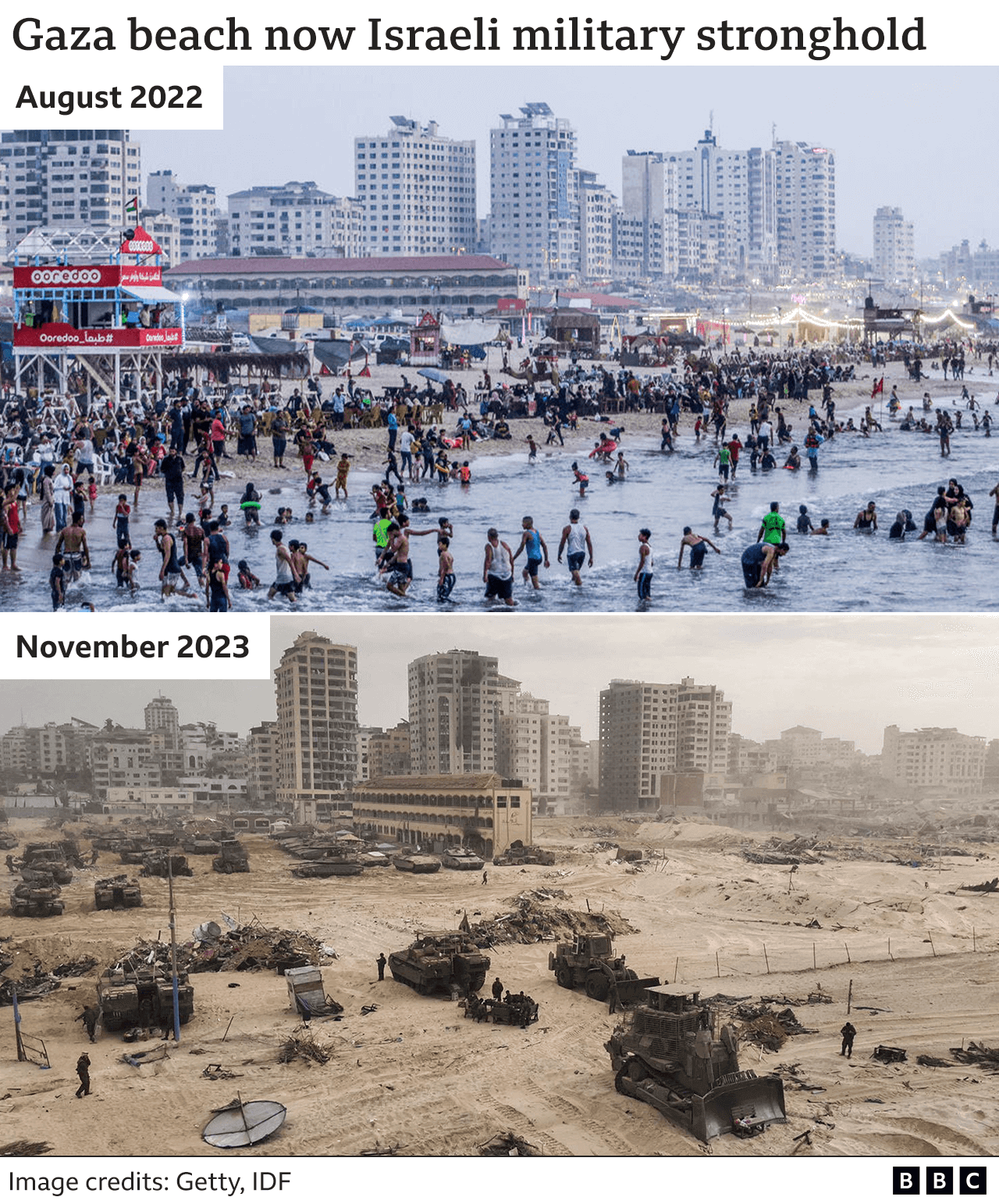Almost two million people in Gaza – more than 85% of the population – are reported to have fled their homes in the two months since Israel began its military operation in response to Hamas’s deadly attacks of 7 October.
The Strip has been under the control of Hamas since 2007 and Israel says it is trying to destroy the military and governing capabilities of the Islamist group, which is committed to the destruction of Israel.
The situation for ordinary people in Gaza – a densely populated enclave 41km (25 miles) long and 10km wide, bounded by the Mediterranean Sea on one side and fenced off from Israel and Egypt at its borders – is “getting worse by the hour”, according to United Nations aid agencies.
Israel warned civilians to evacuate the area of Gaza north of the Wadi Gaza riverbed, ahead of its invasion.
The evacuation area included Gaza City – which was the most densely populated area of the Gaza Strip. The Erez border crossing into Israel in the north is closed, so those living in the evacuation zone had no choice but to head towards the southern districts.

Southern Gaza evacuation areas
The Israel Defense Forces (IDF) are now focusing its operations on southern Gaza and have told Palestinians that even Khan Younis – the largest urban area in the south – is not safe and they should move south, or further west to a so-called “safe area” at al-Mawasi, a thin strip of mainly agricultural land along the Mediterranean coast, close to the Egyptian border.
Fighting in Khan Younis has pushed tens of thousands of people to flee to the southern district of Rafah in recent days, the UN said.
According to the UN, just over 75% of Gaza’s population – some 1.7 million people – were already registered refugees before Israel warned Palestinians to leave northern Gaza.
Palestinian refugees are defined by the UN as people whose “place of residence was Palestine during the period 1 June 1946 to 15 May 1948, and who lost both home and means of livelihood as a result of the 1948 War”. The children of Palestinian refugees are also able to apply for refugee status.
More than 500,000 of those refugees were already in eight crowded camps located across the Strip.
Following Israel’s warnings, the number of displaced people has risen rapidly and 1.9 million have fled their homes since 7 October, the UN says.
On average, before the conflict, there were more than 5,700 people per sq km in Gaza – very similar to the average density in London – but that figure was more than 9,000 in Gaza City, the most heavily populated area.
The UN warns that overcrowding has become a major concern in its emergency shelters in central and southern Gaza, with some housing at four times its capacity.
Many of these emergency shelters are schools and in some there are dozens of people living in a single classroom. Other families are living in tents or makeshift shelters in compounds or on waste ground in open spaces.

Israel has already launched hundreds of airstrikes across Gaza and says it has used more than 10,000 bombs and missiles, causing extensive damage to buildings and infrastructure.
Gazan officials say more than 50% of housing units in Gaza have been destroyed, left uninhabitable or damaged since the start of the conflict.
The map below – using analysis of satellite data by Corey Scher of CUNY Graduate Center and Jamon Van Den Hoek of Oregon State University – shows which urban areas have sustained concentrated damage since the start of the conflict.
They say over 100,000 buildings across the whole Gaza Strip have suffered damage. North Gaza and Gaza City have borne the brunt of this, with around half the buildings in the two northern regions believed to have been damaged, but their analysis now suggests up to 20% of buildings in Khan Younis have also been damaged.
Even healthcare facilities have been left unable to function as a result of bomb damage or lack of fuel.
The UN says hospital capacity in the enclave has more than halved from 3,500 beds before 7 October to about 1,500 now – and “hardly any” in the north.

More than 1,200 Israelis and foreign nationals were killed during the Hamas attacks on 7 October. More than 18,000 Palestinians – including about 7,700 children – have been killed in Israeli airstrikes and operations since then, according to Gaza’s Hamas-run health ministry.
It is difficult for the BBC to verify exact numbers, but the UN’s World Health Organization (WHO) has said it has no reason to believe the figures are inaccurate.
The airstrikes were accompanied by a “complete siege” of Gaza by Israel, with electricity, food and fuel supplies cut, followed by military action on the ground.
The IDF began its ground operations by moving into Gaza from the north west along the coast and into the north east near Beit Hanoun. A few days later Israeli forces cut across the middle of the territory to the south of Gaza City.
Armoured bulldozers created routes for tanks and troops, as the Israeli forces tried to clear the area of Hamas fighters based in northern Gaza.
Having cut Gaza in two, the Israelis pushed further into Gaza City, where they faced some resistance from Hamas.
The image below, released by the IDF, shows tanks and armoured bulldozers on the beach near Gaza City.
A photo of the same beach from last summer shows people making the most of a hot day in Gaza, families splashing in the sea or sitting on fanning out along the beach.

Even before the current conflict, about 80% of the population of Gaza was in need of humanitarian aid, and although Israel has been allowing some aid in from Egypt, aid agencies said it was nowhere near enough.
A seven-day ceasefire at the end of November allowed agencies to deliver an average of 170 trucks and 110,000 litres of fuel a day but that has since fallen to about 100 trucks and 70,000 litres of fuel, the UN’s Office for the Coordination of Humanitarian Affairs (OCHA) says.
“It’s too little, it’s way too little,” the WHO’s Dr Rick Peeperkorn said.
Meanwhile, the WHO has warned that renewed fighting is making the distribution of aid in most of Gaza “almost impossible” and will “only intensify the catastrophic hunger crisis” that already threatens to overwhelm civilians.”
Source : BBC


